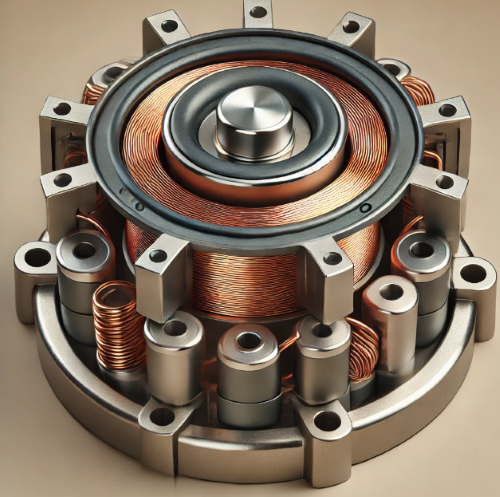The Science of Speaker Magnets: Materials and Properties
Introduction
Speaker magnets are fundamental components in loudspeakers, responsible for converting electrical signals into sound. The choice of magnetic material and its properties significantly influence the performance and quality of the speaker. This topic explores the science behind speaker magnets, focusing on the materials used and their properties.

1. Introduction to Speaker Magnets
– Role in Loudspeakers: Speaker magnets create the magnetic field that interacts with the voice coil, causing the diaphragm to move and produce sound.
– Basic Operation: When an electrical current passes through the voice coil, it generates a magnetic field that interacts with the field of the permanent magnet, resulting in movement and sound production.
Related reading: What Is Speaker Magnet?
2. Types of Magnetic Materials Used in Speakers
—Neodymium Magnets
– Composition: Made from an alloy of neodymium, iron, and boron (NdFeB).
– Properties:
– High Magnetic Strength: Offers a strong magnetic field in a compact size.
– Temperature Sensitivity: Performance can degrade at high temperatures.
– Durability: Susceptible to corrosion without proper coating.
– Applications: Preferred in high-end, compact, and portable speakers due to their powerful magnetic field and small size.
—Ferrite Magnets
– Composition: Made from a ceramic material composed of iron oxide and other metallic elements.
– Properties:
– Cost-Effective: More affordable than neodymium magnets.
– Good Magnetic Strength: Sufficient for most standard speaker applications.
– Temperature Resistance: Stable performance across a wide temperature range.
– Applications: Commonly used in a variety of speaker types, especially where cost is a concern.
—Alnico Magnets
– Composition: Made from an alloy of aluminum, nickel, and cobalt.
– Properties:
– Moderate Magnetic Strength: Weaker than neodymium but still effective.
– Temperature Stability: Excellent performance in high-temperature environments.
– Vintage Sound: Often used in vintage or specialty speakers for their unique tonal characteristics.
– Applications: Used in specific applications where vintage sound qualities are desired.
3. Magnetic Properties and Their Impact on Speaker Performance
–Magnetic Field Strength
– Impact on Sensitivity: Stronger magnets result in higher sensitivity, allowing the speaker to produce more sound for a given input power.
– Impact on Efficiency: More efficient speakers require less power to produce the same sound level, reducing energy consumption.
–Magnetic Saturation
– Avoiding Saturation: Ensuring the magnetic material does not reach saturation to maintain linearity and reduce distortion.
–Magnetic Hysteresis
– Material Selection: Choosing materials with low hysteresis loss to improve efficiency and sound quality.
4. Design Considerations in Speaker Magnet Systems
Magnetic Circuit Design involves optimizing the air gap between the magnet and the voice coil to achieve maximum efficiency. Ensuring uniform flux density across this gap is crucial for maintaining consistent performance.
Voice Coil Interaction requires matching the voice coil design with the magnetic field to ensure optimal movement and sound production.
Heat Management is essential in speaker magnet systems. Considering the thermal properties of the magnetic material helps prevent overheating and degradation, ensuring the system’s longevity and reliability.
5. Advancements and Innovations
- Hybrid Magnet Systems
Combining Materials: Using a combination of neodymium and ferrite magnets to balance cost and performance.
- Miniaturization
Compact Designs: Developing smaller magnets with higher power to fit in portable and compact speakers.
- Sustainability
Eco-Friendly Materials: Researching and developing sustainable and environmentally friendly magnetic materials.
Conclusion
Speaker magnets play a critical role in the performance and quality of loudspeakers. Understanding the materials and their properties helps in designing and manufacturing speakers that meet specific performance criteria. Advances in magnetic materials and technology continue to drive innovation in the audio industry, leading to better sound quality and more efficient speaker designs. For more information, please check Stanford Magnets.